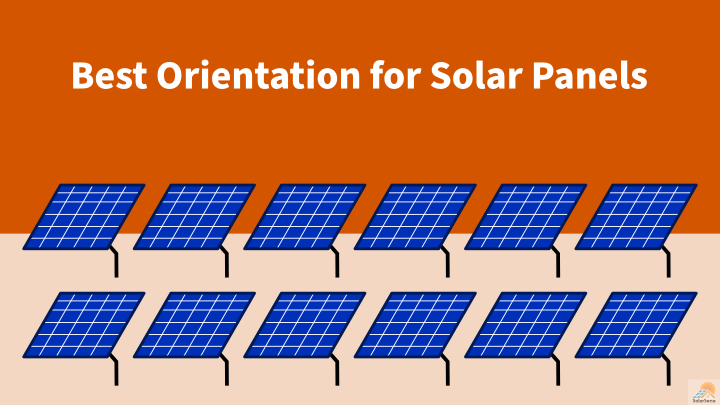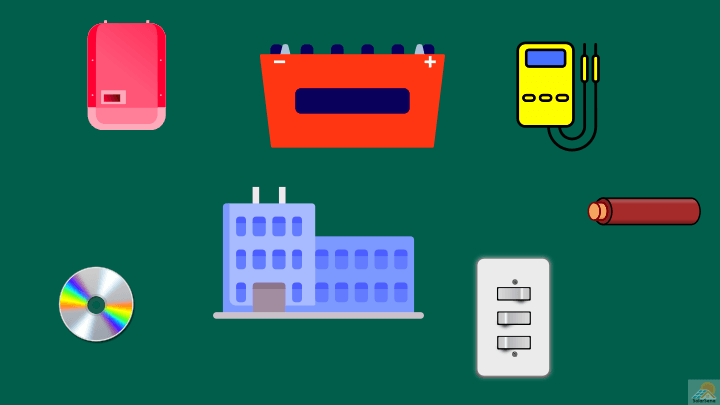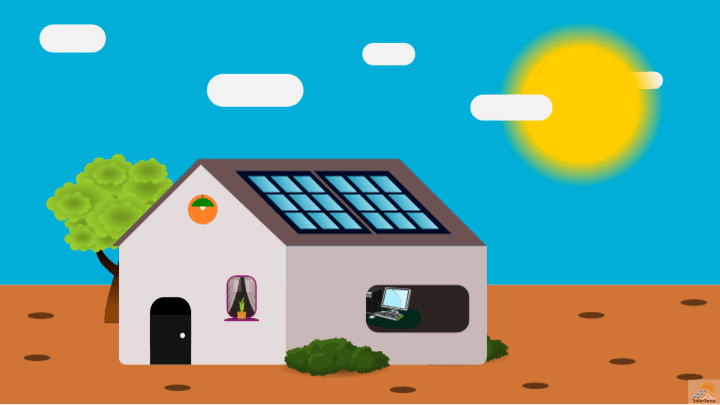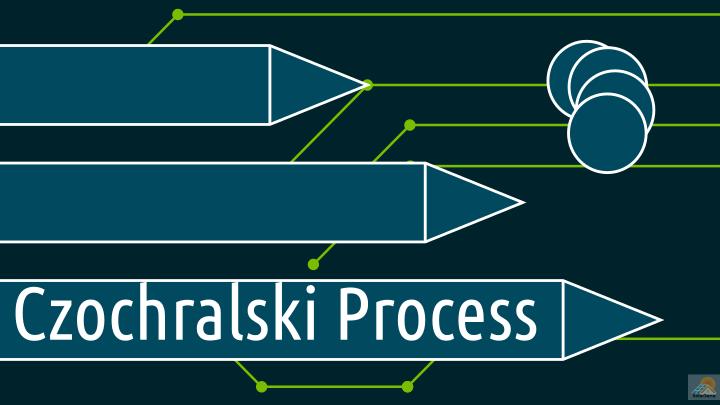The orientation for solar panels is a very important factor to consider before planning for solar panel installation. Understanding the ideal orientation for solar panels will let you know the number of solar panels you need. Subsequently, it will help you to assess the cost of the solar project.
Sometimes finding the best orientation could be not so easy since it depends on numerous factors, like your location, type of mount (ground-mount or roof-mount), shading from surrounding structures, time-of-use, etc. This guide will thoroughly cover all aspects relating to solar panel orientation.
Ideal Orientation for Solar Panels
There are two parts in solar panel orientation: tilt angle for solar panels and direction for solar panels. You have to optimize both of these to get the best orientation for solar panels.

As per the general rule, the ideal direction for solar panels is south for solar panels in the northern hemisphere and north for solar panels in the southern hemisphere. And the optimal tilt angle is equal to the latitude of your location. For example, Los Angeles is in the northern hemisphere and at latitude 34.05° N. So, the ideal direction for solar panels in Los Angeles is south, and the optimal tilt angle is 34°.
We can rewrite the above general rule in simple terms: You should face your solar panels toward the equator. That is because, in the northern hemisphere, the equator is toward the south, and in the southern hemisphere, the equator is toward the north.
You can use SolarSena’s free online orientation calculator to calculate the ideal orientation (both tilt angle and direction) based on your location.
Ideal orientation for solar panels in the United States
The entire United States is in the northern hemisphere, including non-contiguous states: Hawaii and Alaska. Thus, according to the general rule, the ideal recommended direction for solar panels in the US is always south.
Most of the contiguous United States is between the latitude 26° N and 48° N. So, the optimal tilt angle for solar panels in the contiguous US is going to be between 26° and 48°.
The table below presents a list of well-known regions in the US with their ideal orientations.
| Location | Latitude | Optimal tilt angle | Ideal direction |
|---|---|---|---|
| Boston | 42.36° N | 42° | South |
| New York City | 40.71° N | 41° | South |
| Raleigh | 35.77° N | 36° | South |
| Miami | 25.76° N | 26° | South |
| Salt Lake City | 40.76° N | 41° | South |
| Austin | 30.36° N | 30° | South |
| Denver | 39.73° N | 40° | South |
| Phoenix | 33.44° N | 33° | South |
| Los Angeles | 34.05° N | 34° | South |
| San Diego | 32.71° N | 33° | South |
| San Francisco | 37.77° N | 38° | South |
For an exhaustive list, follow this link.
Ideal orientation for solar panels in Australia
Australia is in the southern hemisphere. So, the ideal direction for solar panels in Australia is always north.
The country spans from the latitude 12° to 40°, the optimal solar panel angle in Australia is going to between 12° and 40°.
The below table lists solar panel orientation in some metropolitan regions of Australia.
| Location | Latitude | Optimal tilt angle | Ideal direction |
|---|---|---|---|
| Sydney | 33.87° S | 34° | North |
| Melbourne | 37.81° S | 38° | North |
| Brisbane | 27.47° S | 27° | North |
| Perth | 31.95° S | 32° | North |
| Adelaide | 34.93° S | 35° | North |
| Canberra | 35.28° S | 35° | North |
| Hobart | 42.88° S | 43° | North |
| Darwin | 12.46° S | 12° | North |
Best direction for solar panels
In this section, we will understand why the south is the best direction for solar panels in the northern hemisphere, and vice versa.
Solar panels produce electricity by absorbing sunlight. It is obvious that to maximize the electricity, we have to orient solar panels in a direction that receives maximum sunshine. This direction is decided by the position of the sun in the sky.
Understanding the position of the sun is a bit complicated since the sun’s position keeps changing every hour and every season. In the morning, the sun is in the east, and in the evening, it sets in the west. Instead of tracking the sun every hour, we just want to find the direction where the sun retains most time in the day. And that direction will be the optimal direction for solar panels.
For northern hemisphere
In the northern hemisphere, the months of summer are May to August. During this period, the sun is overhead at noon, as shown in the diagram below. As winter approaches, the sun moves toward the southern sky. Winter is around December in the northern hemisphere.
Needless to say, if you want your solar panels to produce solar power in all seasons and most of the day, you should face panels in the south direction.
South-facing panels will produce power in summer as well as in winter. Further, they will generate considerable solar power from the early afternoon to late afternoon. Solar panels will also deliver electricity in the morning and evening, but it will be marginal compared to afternoon peaks.

For southern hemisphere
In the southern hemisphere, it is the opposite. The summertime is around December, and winter is around June. The sun in June is in the northern sky as depicted in the below illustration, whereas in December, it is overhead.
Hence, the direction that gives maximum sunlight to panels is north.
North-facing panels produce power throughout the year and in all seasons. They also receive maximum sunlight over the entire day similar to south-facing in the northern hemisphere.

Best tilt angle for solar panels
The tilt angle is the angle that solar panels make with the ground. It is a positive number expressed in degrees and is between 0° and 90°. When panels are completely flat, facing to the zenith, the tilt angle is 0°. And when panels are fully vertical, the tilt angle is 90°.
Solar panels absorb most solar energy when the rays of falling sunlight are perpendicular to the surface of solar panels. To achieve this, we have to know the sun’s altitude in the sky, which is measured by the solar elevation angle. Knowing the elevation angle, we can estimate the tilt angle for solar panels, such that the rays of the sun strike perpendicular to the surface of solar panels.
However, the elevation angle never remains constant. It is zero degrees at sunrise and sunset and reaches the highest at solar noon. You cannot always have solar panels facing perpendicular sunlight without the help of solar tracking technology.
A more practical approach for fixed solar panels is to tilt solar panels at an angle equal to the latitude of the location.
At the latitude angle, solar panels perform best in noon peaks, the time when solar insolation is abundant. Also, at the latitude angle, the surface of solar panels gets closer to the desired perpendicularity. This angle outputs optimal power over the entire year and in every season.

Factors that influence solar panel orientation
There are some external factors that influence solar panel orientation. The first is your location, i.e., the latitude of your place, which we have discussed fully in the previous sections. Other factors are as follows:
Orientation of roof
If you have ground-mounted panels, then you can orient them in whatever angle and direction you want. But in the case of the roof-mount, the freedom of the direction and tilt angle is restricted by your roof’s orientation.
In the United States, the south is the best direction for solar panels. However, if your roof is unaligned with the south, then southwest or southeast is preferred. Even those are unavailable, then the east and west are the last choices.
Solar panels facing east produce solar power in the morning, while west-facing panels work in the late afternoon. In both, the west is recommended since the energy demand for typical homeowners is more in the evening than morning. You can also go for a combination of both, depending upon your energy requirements.
In the United States, the north is the worst direction to orient your solar panels. It is never recommended since photovoltaic panels will hardly produce any electricity, and the payback period will jump beyond the acceptable time.
In Australia, which is in the southern hemisphere, the reverse is true. The south is the worst direction to face your solar panels.
For the tilt angle, you will be at the mercy of the pitch of your roof. The pitch of your roof will decide your tilt angle. Typical roof pitch is between 18° to 36°.
Shading
Shading from surrounding structures, like trees or buildings, also affects the orientation of solar panels. In such circumstances, the ideal direction might not be the best, and you might have to consider other alternatives.
To what extent there is shading also counts. There are technologies, like power optimizers, microinverters, that can reduce the impact of shading on the final power output.
Time-of-use and your energy profile
Many utilities charge power based on the time of the day. For example, utility providers may charge more in the evening than in the morning because of high energy demands. In that case, tilting solar panels at higher angles makes sense since your photovoltaic panels will produce more power in the evening when rates are higher, and you require more power.
If you have storage batteries or net-metering included in your photovoltaic system, the situation might be different. That is because you can save surplus energy produced during afternoon peaks and use it up in the evening.
The energy profile for householders also changes with seasons. For example, in summer, you might consume extra energy than normal because of air conditioning. Or in the wintertime, there is a need for heating the room. We can increase the power output of solar panels according to seasons by correcting the tilt angle.
As in bright summer, the sun is at high altitudes, so decreasing the tilt angle will make solar panels flatter, and they will produce more power in the summer months. On the other hand, the sun is at low altitudes, near the horizon, in the cold winter. So, we have to make solar panels more vertical by increasing the tilt angle.
You can use SolarSena’s tilt angle calculator to estimate the tilt angle for different seasons.
FAQs
What is the best house orientation for solar panels?
A house with a roof facing south is the best orientation for solar panels in the northern hemisphere. And roofs facing north is the best orientation for solar panels in the southern hemisphere.
What is the best orientation for solar panels in the United States?
The United States is in the northern hemisphere, so the best orientation for solar panels in the entire US is always south.
Are solar panels facing west a good choice?
West-facing solar panels work only between afternoon and evening. They might be recommended if your utility offers the time-of-use plan.
What should be the roof angle for solar panels?
The roof should be inclined at an angle closer to the latitude of your location. For example, San Diego is at 32.72° N, so the best roof angle in San Diego is 33° for maximum solar power.



